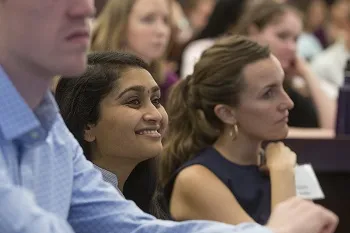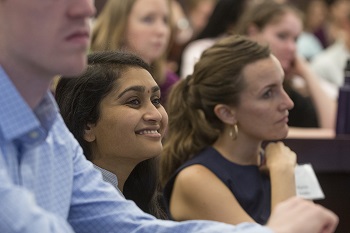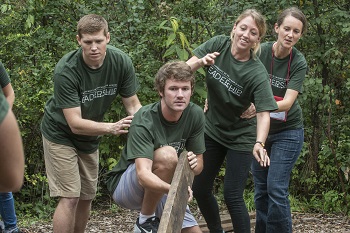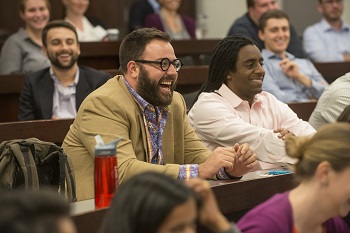Kapnick’s Second Year: How Brain Science Fuels the Law School’s Powerful Leadership Program

Nabihah Maqbool, ’18, hadn’t practiced her speech, and this was by design.
She didn’t want to sound overly rehearsed or end up struggling to remember what came next. She’d chosen a familiar topic—Kanye West—and she felt reasonably equipped to address the seven classmates, two facilitators, and one visitor in the basement study room at Booth. She’d worked as the co-director of the Muslim Speakers Bureau of Columbia while earning two degrees at the University of Missouri and had participated in debate competitions in high school. She knew a thing or two about public speaking.
Still, as she stood to take her turn at the front of the room, Maqbool could feel her pulse quicken. She had a basic outline in her head, and she knew she wanted to begin by repeating President Obama’s oft-quoted comment on the rapper’s behavior. But the rest? She’d just have to trust her gut.
She took a breath, looked at the camera and the ten sets of eyes, and began: “He’s a jackass.”
The hardest part of the exercise, one of her classmates would later say, wasn’t summoning the words or remembering to make eye contact—it was doing those things while feeling exposed and unsettled. (“Everyone’s instinct is to flee the second they finish,” one student observed during the session). This wasn’t like lecturing from notes or even addressing a packed auditorium; this was about thinking on one’s feet and captivating listeners whose faces were close enough to telegraph their amusement, fascination, or boredom. It was, in a way, disarmingly intimate.
Which is why the Kapnick Leadership Development Initiative’s intensive public-speaking module, Captivating the Audience, works: it strips an experience crucial to effective lawyering down to its gears, then shines a light on the speaker’s natural tendencies, laying bare the fears and crutches that might keep her from truly conveying her message. It can also pinpoint unrecognized strengths and, like other parts of the acclaimed Kapnick program, help students build a roadmap for future development. After all, Maqbool and her classmates didn’t just have to prepare a talk and manage their nerves—they had to go one step further, watching themselves on video, listening to feedback, and then reflecting on the habits and feelings that had impacted their ability to captivate. They had to connect the dots.
“The common theme for all of Kapnick was: even if you think you’re comfortable or already have skill in a field, there’s so much more you can improve,” Maqbool said. She received feedback on dramatic pauses, vocal inflections, and “showing” instead of “telling,” and in the end, she dropped the “jackass” line in favor of some provocative lyrics that illustrated West’s work. But the real opportunity came from seeing herself as others did; self-awareness, she and her classmates would learn, is good for the brain.
In its second year, Kapnick has been as much about the quiet power of little revelations as about the introduction of bold ideas. New modules on conflict management and introvert/extrovert social types offered additional layers of self-evaluation, but the overarching theme of the program remained the same: the best lawyers bring a full set of skills, and that means strengthening all parts of the brain, not just the centers of logic and intellect. Advances in neuroscience and psychology—research that underpins many parts of the Kapnick program—have shown that humans, even smart ones, generally aren’t good at knowing what they want, or predicting what will make them happy, or knowing that the image in their head isn’t the one they’re projecting to the outside world. And they don’t always respond in the most effective way, especially when they’re frustrated, stressed, upset—or feeling exposed.
the Kapnick program—have shown that humans, even smart ones, generally aren’t good at knowing what they want, or predicting what will make them happy, or knowing that the image in their head isn’t the one they’re projecting to the outside world. And they don’t always respond in the most effective way, especially when they’re frustrated, stressed, upset—or feeling exposed.
There’s good reason for this, though experts are just beginning to fully understand the implications: logic and reasoning live in parts of the brain that don’t always communicate efficiently with the parts that process emotion. Kapnick, in essence, works by helping students rewire their brains to overcome this inefficiency—not by making them different people, but by gradually strengthening the connections between the centers of emotion and logic. Participants learn to recognize and assess behavioral tendencies, and they develop a framework for deciding when to override their gut response and shift into less comfortable territory.
“There are these ‘shattered glass’ moments in Kapnick where you see yourself in a new way, and I think the program is at its best when this self-awareness comes, at least momentarily, as a surprise,” said Josh Savitt, ’16, one the program’s student facilitators. “But there’s this other moment that often comes after the surprise, this moment when they say, ‘Actually, I think maybe I knew that all along—I just never articulated it.’ That’s when you know that the message has sunk in. They’re able to think about it consciously, and they have a language for talking about it.”
For instance, Maqbool, who worked in public health policy before coming to law school, realized during Kapnick that she still saw herself as the “brash and combative young person” she’d once been as opposed to the more even-keeled and cooperative woman she’s become. Her brain hadn’t updated its internal narrative, so she wasn’t always on the lookout for the right stumbling blocks.
“I found out that I had shifted completely to the ‘accommodating’ scale, which at first I found completely shocking,” Maqbool said. “But this is good to know, and it’s better to know it now, at the beginning of law school. If a situation requires me to be assertive or competitive, I can be mindful not to let things slide or give in to the part of me that’s willing to lie down.”
When the program debuted last year as the result of a $2 million joint gift to the Law School and UChicago's Booth School of Business by Scott, JD/MBA ’85, and Kathleen Kapnick, ’84, it marked the first time an elite law school had launched a major initiative to equip students with the communication, leadership, and conflict management skills that are now commonly recognized as critical differentiators in a legal market that prizes interpersonal savvy alongside analytical brilliance. Almost right away, it met with praise—faculty saw a difference in class, students reported feeling more connected to their classmates—and other law schools began calling, asking to hear more.
“How you say something as a lawyer is as important as what you say,” Dean of Students Amy M. Gardner, ’02, said. “The reason we launched Kapnick—and the reason it has been so positively received—is that being able to communicate effectively, build trust, and manage conflict aren’t just nice extras anymore, they are essential to success in today’s legal workplace. Employers don’t want to have to teach new graduates interpersonal skills on the job. They want lawyers who can leverage the full weight of their intellect right from the start.”
 The mandatory 1L program, modeled on Booth’s Leadership Effectiveness and Development (LEAD) course and tailored to the Law School, runs mostly during orientation and starts with a two-day retreat that includes team-building exercises on an outdoor ropes course. In classroom sessions, led by Law School and Booth students who have been trained as facilitators, students receive feedback on first impressions; explore how their own personality traits affect group participation, leadership, and conflict-management tendencies; and discuss strategies for building relationships and communicating effectively.
The mandatory 1L program, modeled on Booth’s Leadership Effectiveness and Development (LEAD) course and tailored to the Law School, runs mostly during orientation and starts with a two-day retreat that includes team-building exercises on an outdoor ropes course. In classroom sessions, led by Law School and Booth students who have been trained as facilitators, students receive feedback on first impressions; explore how their own personality traits affect group participation, leadership, and conflict-management tendencies; and discuss strategies for building relationships and communicating effectively.
In a survey that was given at the end of this year’s Kapnick program, the majority of 1Ls reported that they had gained new insights about teamwork, their own conflict-resolution styles, and the importance of building and maintaining successful professional relationships. Nearly 95 percent of students said they developed good friendships with classmates as a result of the program, and more than 84 percent said they would recommend Kapnick to future law students.
“To be given this as a 1L really shows how much the Law School is willing to invest in us, and right from the very start,” Maqbool said. “I think my Bigelow group really understood why this matters, why these are important skills. You can be a great thinker, but if you can’t cooperate or communicate with someone, you’re not putting your thinking skills into use.”
Facilitator Michael Savage, ’16, put it another way:
“At a law firm, you get paid by the hour,” he said. “The more quickly you can convey a clear message, the better it is for your client.”
Building an Overpass in the Brain
In basic terms, Kapnick matters because the human brain isn’t really wired to maintain complex cognitive function—critical thinking, emotional regulation, social control, decision-making—when things get stressful. It doesn’t matter how analytically smart we are; emotional intelligence is a different beast.
Most of us are familiar with the evolutionary significance of this set-up: earlier humans relied on the reflexive fight-or-flight response to survive the various dangers of their prehistoric world. Much of the information needed for these reactions is processed in the brain’s quick-acting amygdala, which is responsible for multiple emotional responses. When the amygdala lights up, it can impair the critical-thinking center—located in the more-evolved prefrontal cortex—and this can hurt a lawyer’s ability to think on her feet and make logical judgments. What’s more, the timing favors emotion over logic: the amygdala can trigger an emotional response almost instantly, unlike the prefrontal cortex, which takes longer to kick in with strategy and logic.
“This not only helps explain why it is hard for people to figure out what makes us happy, but it also gets to the heart of why it can be difficult for us to manage our emotions,” said Robin Ross, Executive Director of the Law School’s Doctoroff Business Leadership Program and an executive coach who has studied the role the brain plays in developing interpersonal and leadership skills. “The old advice to ‘count to ten’ or ‘take a deep breath’ makes perfect sense: you need to stop and breathe, because your amygdala has a hair-trigger that goes off in a millisecond. But it takes several seconds for the prefrontal cortex to fully engage so that we can thoughtfully respond to a situation, rather than react.”
But there’s good news: the brain is not a physically static organ; shifts in behavior, environment, thinking, and emotions can change those neural pathways. It’s a concept known as neuroplasticity, and it’s why Kapnick both works—and doesn’t work right away.
“When you focus on or practice something, you create and strengthen new neural connections,” said Ross, who last year participated in a six-month certificate program through the NeuroLeadership Institute, a research organization focused on bringing neuroscience to leadership. “One author likened building new habits to building an overpass in your brain. It’s not that you completely lose the old neural pathways, but over time, and with effort, you can learn to re-route your thoughts and actions onto the overpass.”
One way to think about Kapnick: The classroom sessions help students build the overpass, brick by brick. In the weeks and months that follow, the students begin taking that overpass—applying the insights and lessons in class or in jobs—and eventually it becomes their standard route.
“And that’s the key—continual practice,” Ross said. “Every time the students manage their emotions well or respond in a more diplomatic way or make someone feel more comfortable, it’s just like exercising a muscle at the gym. Changing behavior first requires self-awareness, and then it requires practice.”
When the program debuted last year, students reported feeling a domino effect: one small insight led to another, which led to another, and so on. No one moment represented a colossal leap, but as they applied what they had learned during orientation—as they strengthened new brain connections and learned to take the new overpasses they had built—their skills grew and evolved.
“That’s the challenging part but also the great part of the program,” said Lauren Faraino, ’16, one of this year’s Law School facilitators. “You have these lessons that hopefully will resonate with students right away but won’t be truly felt until several years down the road.”
For some, the insights clicked because they solved a nagging problem or allayed a chronic worry; they were eager to take the overpass because they were already looking for a new route.
“I tend toward a leadership role, but I’d always been afraid that I came across as domineering,” said Amelia Mattia-Garza, ’18. “But our facilitator said that taking the lead was a perfect role for me. Then he gave me specific tips—things that seem obvious now but just didn’t occur to me before: if you’re worried that you’re stepping on other people’s toes, ask questions and focus on listening. Just to have that re-emphasized was really, really helpful. I was optimistic going in to Kapnick but even so, I didn’t realize it was going to be as useful as it was.”
 Many students said they’d had previous exposure to some of the Kapnick topics, and this fueled additional interest. The new introvert/extrovert session, for instance, was optional but still drew a standing-room-only crowd. Many students said they recognized the prevailing disconnect in how Americans tend to view these types: the forward gregariousness of the typical extrovert is often held up as the ideal, even though studies have shown that it can impede performance and that the ability to listen and analyze—signature introvert traits—are crucial. The preference is so ingrained, however, that the students tended to assume that many of their classmates were extroverts—even though a personality assessment showed that more than half are, in fact, introverts.
Many students said they’d had previous exposure to some of the Kapnick topics, and this fueled additional interest. The new introvert/extrovert session, for instance, was optional but still drew a standing-room-only crowd. Many students said they recognized the prevailing disconnect in how Americans tend to view these types: the forward gregariousness of the typical extrovert is often held up as the ideal, even though studies have shown that it can impede performance and that the ability to listen and analyze—signature introvert traits—are crucial. The preference is so ingrained, however, that the students tended to assume that many of their classmates were extroverts—even though a personality assessment showed that more than half are, in fact, introverts.
“The reality is that each of these styles have their virtues and their limitations,” said Christopher D. Collins, Booth’s Associate Dean of Leadership Development. “The introvert/extrovert session was a great opportunity for us to reiterate this central message—one that punctuates our entire curriculum in Leadership Development—and to do so in the context of an individual difference that relates closely important leadership and legal skills.”
The importance of recognizing one’s personal style as a way of strengthening these core action skills is a concept students have reported hearing from all corners—including employers. Several of the facilitators said the attorneys they encountered during summer jobs were intrigued and enthusiastic when they mentioned Kapnick and the Law School’s willingness to focus on leadership skills.
“They said this is what gives lawyers their edge,” Savitt said of the attorneys he worked for at Sidley Austin’s New York office this summer. “I was talking with one very successful partner who was telling me about another, slightly more successful partner, and he said, ‘You know what difference between us is? I can give the same advice he can, but he knows how to have a conversation with a client that lets the client think it was his idea in a way that makes the client feel smart, and happy, and empowered. The fact that he’s able to do that—that’s an additional layer. Clients just love working with him.’ ”
Connecting, Communicating, and Resolving Conflicts
Building a new overpass, of course, isn’t easy. Sometimes, during Captivating the Audience, the butterflies took over.
One student was so nervous, and so sure that everyone could tell she was nervous, that partway through she drew a blank, stopped, and asked if she could pull out her notes—which she then barely used. What’s more, she seemed surprised when her classmates revealed that they hadn’t known she was struggling until the moment she stopped.
Facilitators work to create a safe, supportive environment during Kapnick, but that doesn’t eliminate every shred of discomfort. A participant watching herself on video might realize that she talks over other people, or giggles when she’s nervous, or retreats at the first sign of controversy; her first-impression feedback might reveal a tendency to come off as militant, insecure, or cold.
“Confronting a habit that doesn’t serve us well is rarely comfortable, but it is better to have that experience at the beginning of law school rather than six months—or several years—into your career,” Gardner said. “Kapnick gives students the framework they need to begin assessing their personal leadership and communication style now, when they have the space to focus on developing these skills. They may not realize it now, but this will be a big advantage when they graduate.”
This year, Gardner and other Kapnick leaders added a module on conflict resolution, which Gardner has noted is particularly essential for future lawyers. In those sessions, students used a tool called the Thomas-Kilmann Instrument to examine their own tendencies in dealing with interpersonal conflict. The TKI, which has been used by millions of people worldwide, describes five modes into which a person might fall on a scale measuring assertiveness and cooperativeness: collaborating (both assertive and cooperative), accommodating (unassertive and cooperative), compromising (moderately assertive and moderately cooperative), competing (assertive and uncooperative), and avoiding (both unassertive and uncooperative). Once students know how they tend to respond, they can put that in to context, considering when their default mode helps—and when they might be better served by “flexing” into a different area. For instance, although collaboration is the goal in many situations, even avoidance has its place because not every battle is worth fighting.
“It is basically rational choice theory for managing conflict,” Collins explained. “It’s figuring out which approach has the best cost/benefit ratio and flexing into that area.”
Tom Molloy, Jr., ’18, who worked as an assistant pastor and then taught religion and philosophy at a small liberal arts college, tends toward collaboration, the mode in which he received the highest TKI score, and competitiveness. His third highest, however, was avoidance. “I value my opinion and I’m willing to fight for it, but if I feel I’m failing to make headway, rather than compromising, I tend to withdraw—I take my ball and go home,” Molloy said. “This has its benefits, but it also has downsides.”
Molloy’s post-Kapnick goals include working on his accommodation and compromise skills so he can flex into those areas when the situation demands it.
“This kind of work benefits from constant refreshing and constant review because it’s easy to know these things abstractly but it’s another thing to continually reflect on yourself—there’s always something to improve,” Molloy said.
For some students, the focus on self-reflection was new territory. But each revelation—figuring out that they freeze when they feel exposed, or realizing that they become combative when questioned, or learning that it is OK to be an introvert—was another brick in their overpass. Many were thoughtful as they considered what came next, saying they had a new appreciation for why interpersonal skills matter.
And that appreciation grew, in part, from the knowledge that the program’s content and design were rooted in science; for a law student who is naturally wired to think analytically, that can make a difference.
“Kapnick did a great job of not being too simplistic about these concepts,” Molloy said. “And the fact that it is research- and data-driven—that’s huge.”